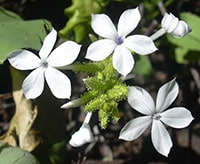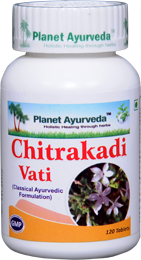Chitrak (Plumbago zeylanica) - Properties, Benefits & Dosage
Description of Plant

Chitrak is an herbaceous plant with glabrous stem that are erect, climbing and have numerous stems. This plant grows up to height of 3-4 feet. Leaves are 4cm long, thick, fleshy, sessile, oval and lance-elliptic in shape with hairy margins. Base of the leaf is attenuate and apex is obtuse or acute in shape. Bisexual flowers of this plant are white colored, 10-25cm long and are arranged in terminal and axillary elongated spikes and this plant appears throughout year. Stalked and sticky substance densely covers the calyx. Calyx is totally covered with granular hair and it is capable of killing and trapping insects by secreting sticky mucilage. Fruits have apex are small and have 5 furrows. Fruits contain single seed that is oblong about 5-6mm long and reddish brown to dark brown in color. Fresh straight and slightly branched roots are light yellow colored and dried roots are reddish brown with a pungent odor.
General Information
The name Plumbago is derived from word "plumb" that means lead and agree to convey and commonly Plumbago zeylanica is known as Ceylon leadwort, doctor bush and wild leadwort. One of very effective digestive and carminative herb is Chitraka. In ayurvedic medicinal system Chitrak is considered as rasayan. This versatile herb is three colored flowers are red, white and blue. It is very important medicinal herb and roots of this herb are very effective for cardiac disorders, hepatic disorders and disorders associated with nervous system.
According to vagbhata there are three varieties of Chitraka:-
- Shweta Chitraka
- Peeta Chitraka
- Asita Chitraka
Roots of Chitrak contain a yellowish pungent substance called plumbagin. This chemical compound found in Chitrak is poisonous in nature. Other chemical compounds found in plumbago are 3-chloroplumbagin, plumbagic acid, glucose, fructose, sucrose, hydroxyproline, isozeylinone and aspartic acid.
Juice of roots of Chitrak is used to provide blue and black coloration in tattoo formation in Hawaii.
Habitat
Plumbago is mainly native to old tropical regions of pacific and Hawaiian island. It is cultivated for medicinal and commercial purposes. Chitrak is densely distributed found in south India and Sri Lanka. In India it is also easily available in Bengal and Uttar Pradesh.
Special note about Plumbago Zeylanica
Chitrak roots are poisonous in nature and for its use purification of Chitrak roots are very important. The roots are cut into small pieces and immersed in lime water for three hours. Immersed roots are taken out and again dipped in lime water. This process is repeated for three times to obtain pure Chitrak roots.
Classification
- Kingdom - Plantae
- Order - Caryophyllales
- Family - Plumbaginaceae
- Subfamily - Plumbaginoideae
Names
- Latin name - Plumbago zeylanica
- Hindi name - Chitrak, Cheeta
- English name - Leadwort, Doctorbush
- Bengali name - Chita
- Kannada name - Chitramula, Vahni
- Malayalam name - Vellakeduveli
- Oriya name - Chitamula
- Punjabi name - Chitra
- Telugu name - Chitramulam
- Marathi name - Chitramul
- Gujarati name - Chitro
- Tamil name - Chittiri, Chittira
- Arabian name - Sheetaraj
- Farsi name - Sheetar
Ayurvedic properties
| Hindi / Sanskrit | English | ||
| Rasa | Katu | Taste | Pungent |
| Guna | Laghu, Rookash, Tikshana | Physical Property | Light, Rough, Sharp |
| Virya | Ushna | Potency | Hot |
| Vipaka | Katu | Metabolic Property (After Digestion) | Pungent |
Effects on Dosha
It balances vata and kapha dosha.
| Charak Samhita | Sushrut Samhita | Vagbhata |
|
Amalkyadi, Pippladi, Mustadi, Varunadi, Aragvadhadi | Pippalyadi, Mustadi, Varunadi, Aragvadhadi |
Ancient Verse about Plumbago Zeylanica

Chitrak, analnama, pathi, vyaal and ushan are Sanskrit names of plumbago. It is pungent in taste after digestion, stimulant, digestive, rough and has hot potency. This herb is used in mal absorption syndrome, leprosy, inflammation, piles, and worms and to cure cough. It is absorbent and it helps to pacify all three body doshas.
Practical uses from Plumbago Zeylanica
- Root powder of plumbago is very effective for the sufferers of diarrhea and piles.
- The main chemical compound plumbagin helps to boost up immunity.
- This herb is used to expel out thick nasal mucus which is main cause of recurrent common cold and cough.
- It is used to reduce inflammation and very effective in bronchitis and chronic sinusitis.
- Root of plumbago is used to increase appetite and stimulate digestive system. It is used to stimulate digestive power and used as carminative.
- Roots are also used to cure the spleen enlargement.
- Leaves of this plant are capable for treating laryngitis and rheumatism.
- External paste of this herb is used to reduce skin inflammation, filariasis and various other disorders associated with skin.
- Paste of roots are applied externally on carbuncles, wounds and syphilitic ulcers.
- Pure extract of this herb is used in lowering cholesterol level.
- It is used to inhibit the growth of cancer causing cells of prostate.
- Plumbago enhances liver power and it is also used as liver tonic.
- This herb is anti-inflammatory in nature and used to reduce swelling.
- It is also beneficial in osteoarthritis and rheumatoid arthritis.
- According to Ayurveda Chitrak rejuvenates body and is used as rasayana.
- It is used for pacification of vata and kapha dosha.
Part used
- Leaves
- Root
Dosage
- Root powder - 1-3gm
Cautions
This herb is not prescribed in pregnancy.
Heavy dose may cause heavy periods.
Excess use of this herb may cause gastritis, burning sensation and neuropathy.
Ayurvedic Products from Plumbago Zeylanica
Chitrakadi vati
Chitrakadi Vati of Planet Ayurveda is one of the best poly herbal ayurvedic classical formulation for indigestion. 'Chitraka' is the name of 'fire' in Sanskrit. The main ingredient of Chitrakadi vati is Chitraka Mool (root of Plumbago zeylanica) which is considered as good appetizer. According to Ayurveda, Chitrakadi Vati comprises dual properties i.e. Deepaniya (appetizer) and Pachaniya (digestive), which supports digestive system. If taken before meal it acts as an appetizer and as a digestive if taken after meal with water. Chitrakadi Vati increases digestive fire as a result increases appetite and helps the liver to function better.
Due to lack of digestive fire 'Aama' is formed which leads to formation of endotoxins which, are root cause of many auto-immune diseases like rheumatic disease, gout etc. Chitrakadi Vati removes Aama Dosha. This formulation mobilizes deposited fat from the tissues. Chitrakadi Vati increases Pitta and balances Vata in the stomach. It stimulates secretion of gastric juices. Chitrakadi Vati has anti-spasmodic and carminative action. Chitrakadi vati stimulates metabolic rate of the body. The peristaltic movements of the intestine are regulated by its intake as a result of which, the out flow of undigested food in the form of loose stool is restricted.




